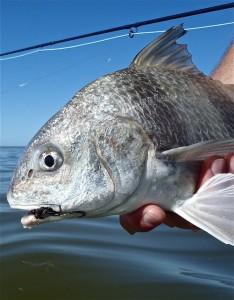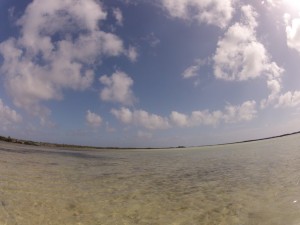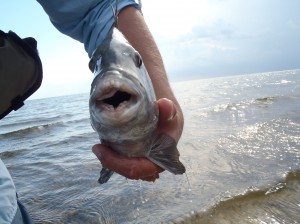Taking good advice and 'doing it all'
You might have seen a previous blog entry from TROUT Magazine's editor, Kirk Deeter, on "doing it all" in order to hone your skills as an angler and venture farther down the path to becoming the "complete angler" we all want to be. If you didn't, it's worth a read.
Sunrise over Laguna Madre
The post was of particular interest to me because, even though I live within 45 minute of the Henry's Fork here in eastern Idaho, I've become enamored of late with saltwater fly fishing. In the last two months, I've traveled south twice to warmer climes (an Idaho winter will do that to you) to chase ocean-dwelling fish with heavy fly tackle. In the spirit of "doing it all," I've laid bare my less-than-stellar skills on the flats.
But I'm learning. And, for me, as I suspect it is for most anglers, learning and improving at the craft of fly fishing is a wonderful part of a much larger journey.
Last week, I ventured to south Texas' Laguna Madre, home to tailing redfish, speckled sea trout, black drum and other, more interesting critters, like sheepshead and ladyfish. Fishing was predictably slow (a condition that, unfortunately, seems to follow me around like a hungry puppy), but with good advice, an open mind and the aforementioned fact that I'm learning the ins and outs of casting to saltwater fish, I managed to move the meter a bit on my own "complete angler" journey.
I caught my first black drum--I cast accurately to a tailing fish and managed to hook up. I caught a small redfish on the sand flats north of the resort community of South Padre Island. And I cast. A lot. With wind in my face and less-than-cooperative fish, I devoted some time on the water to analyzing, critiquing and practicing my cast.
And I used some the seemingly less important skills that I'd picked up on other flats fishing adventures. For instance, on a trip to the Bahamas in March, I really struggled, not only with the wind and what I figured at the time to be a hopeless "trout cast," but also with one of the skills that's virtually vital if you are to succeed on the flats--the ability to see fish.
If you've never done it, take my word for it. It's not as easy as you might suspect. They don't just show up and present themselves. Saltwater fish, when they're on the flats, are always moving. They offer up little clues, small, tell-tale give-aways that can help you find
them. Sometimes--very rarely--you'll just see them. More often than not, you'll pick up a quick flash from a wet tail catching the sun just right, or you'll see some "nervous water" that moves differently than the surface of the rest of the flat. Eventually, when you catch these little clues, it'll be easier to actually see the fish and prepare for them.
So, last week, after hiking a couple of miles over the dunes on South Padre Island and wading another mile of shin-deep flat, the "fish eye" kicked in. And, for just a few minutes, the wind died down.
With the tide on the way out, I could see a lot of baitfish moving off of a network of really shallow flats (only inches deep), using little cuts and "creeks" as highways back to the deeper water. I suspected that Laguna Madre's redfish and trout might be lying in ambush near these little structural anomalies (using a skill plucked from my much more developed trout fishing repertoire--reading the water), and we paid special attention to this water.
As the tide continued to recede, we were growing less optimistic about our chances. To the north, the skies were darkening and the predicted thunderstorms, while late, were on the way. We were just about to call it a day when I noticed something out of the ordinary.
Ahead, about 30 yards, I saw what I like to call "bouncing" water. My time on the Bahamas taught me that nervous water usually meant bonefish. Here, on the south Texas flats, I immediately thought redfish. I watched the water closely, and as the nervous water got closer, I spied three large fish moving toward me. They weren't redfish. The vertical bars on their bodies gave them away. Through the crystal-clear water of the bay, I knew I was looking at sheepshead.
I immediately loaded my rod and sent a cast toward the fish, which were actively feeding. The cast, predictably, landed short. I waited. As the fish moved closer to the fly resting on the bottom, I gave the fly--a red and yellow Clouser--a little twitch. One of the fish broke off from the crowd and curiously moved toward the fly. I stripped it again. And again. The fish followed the fly to within about 10 feet of me before it saw me. It bolted.
I changed flies, keeping an eye on the water ahead of me. Ahead I noticed not one, but
three waves of fish coming my way. I cast the new fly, a small green-and-white baitfish pattern. Same story. I got a follow, but no take.
Finally, I tied on a small crab pattern. Scanning the water, I identified another pod of feeding fish. I loaded the rod and sent what I honestly believe to be the cast of my life about 80 feet over the flat and plopped the fly right in front of the fish. Two strips later, I was into my first sheepshead.
Practice makes perfect. Experiencing the craft's many facets adds to the enjoyment of it. Deeter's right. Do it all. You'll be a better angler for it.






Comments
I saw that eighty foot cast and I still don't believe it. A fine piece of fishing, I must admit. Here's to doing it all!